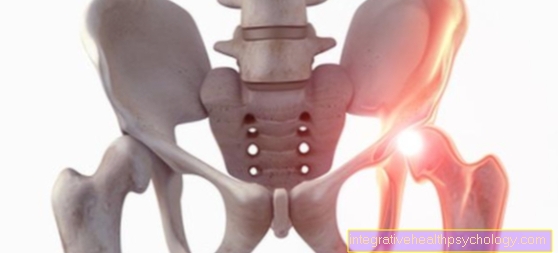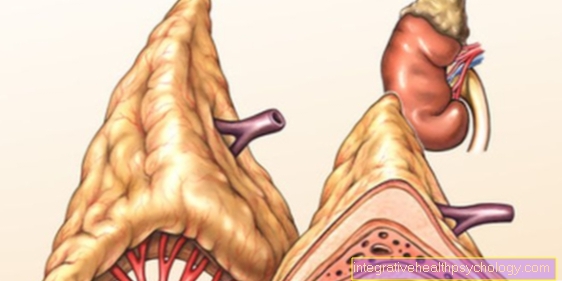Stomach reduction
introduction
In Germany about 55% of the population are overweight at the moment, that means they have a BMI over 25. In fact, about 13% of the people in Germany are pathologically overweight.
Stomach reduction is the reduction in size of the stomach with the aim that less food is consumed and pathological obesity (Obesity) is fought. There are various methods of surgically reducing the size of the stomach, which are usually only covered by health insurance companies under certain conditions. In Germany, however, a change in thinking can be observed. Excessive obesity is increasingly recognized as a chronic disease and is therefore accepted more and more frequently. At the moment there are around 2500 to 3000 operations per year that use various techniques to make the stomach smaller.

Requirements for an operation
Since a stomach reduction is an invasive procedure that can also lead to many complications, there are some requirements that must be met for surgery.
- These include a BMI> 40
- Or a BMI> 35 (in individual cases a BMI of 30 is sufficient) if there are concomitant diseases, such as Diabetes mellitus, high blood pressure, joint disease or sleep apnea (breathing stops during sleep).
- The obesity must also have existed for more than three years and all other less invasive measures for weight loss should have failed.
Only people between the ages of 18 and 65 are operated on.
If the stomach is downsized, there should be no addictions (such as drugs, tablets or alcohol), as this could lead to a shift in addiction. Since the food addiction is no longer possible due to the smaller stomach, some patients switch to other addictive substances. People who suffer from depression cannot have an operation either.
The patient must be motivated to fully participate in the treatment, since an operation to reduce the size of the stomach is not enough. According to this, there are severe restrictions in everyday life, in particular the rules for the following diet. The patient must be informed about all risks.
Procedure for stomach reduction
The desired weight reduction can be achieved using various methods. In some, the stomach itself is made smaller (restrictive techniques) with other surgical techniques the stomach is bypassed in the digestive tract (bypass Techniques).
With the restrictive methods, the stomach is made smaller using a so-called gastric band or similar methods. Therefore, even after very small amounts of food, you will feel full and automatically eat less. Digestion is less affected by these methods because all parts of the stomach are still present. However, it can still happen that you don't keep your reduced weight so easily if you don't eat disciplined. Liquid or pulpy food can easily pass through the reduced stomach and is fully digested, so all calories are also absorbed. That would be particularly dangerous with ice cream, puddings and sodas of all kinds.
With the bypass methods, the stomach is bypassed directly, i.e. the esophagus is separated from the stomach and sewn directly back to the duodenum. With this method, the food is digested less strongly and thus fewer calories are absorbed, so the various bypasses belong to the malabsorptive (low or poor food intake) procedures.
Below is an overview of all stomach reduction procedures:
- Gastric band
- Gastroplastics
- Gastric bypass
- Sleeve stomach
- Roux En Y bypass
- Small bowel bypass
- Biliopancreatic version
- Gastric balloon
- Gastric pacemaker
Duration of the operation
A stomach reduction is a major surgical procedure that cannot be reversed. A distinction is made between gastric bypass and gastric tube surgery.
With a stomach tube resection, most of the stomach is removed so that only a small stomach tube remains. This procedure is technically less demanding than gastric bypass and the operation time is around an hour. Then there is the preparation time and the aftercare after the operation.
With gastric bypass, the food is channeled past the stomach via a short circuit with the small intestine. Depending on how complicated the operation is, the duration of the procedure is between two and five hours.
Length of hospital stay
After gastric bypass, patients have to stay in the hospital for five to seven days. During this time, the patient recovers from the operation and slowly gets used to his smaller stomach and the associated change in diet.
Surgery cost
In bariatric surgery (bariatric surgery) there are various methods to "shrink" the stomach and thus achieve weight loss. The costs are either borne by the health insurance company or borne by the patient himself.
- Cost of a gastric balloon: The gastric balloon (itragastric balloon) will i. d. Usually patients with a BMI between 28 and 44 (rarely between 26 and 46) are used. It is a non-invasive way of reducing the size of the stomach by filling the balloon with a large volume of filling. The cost of inserting a gastric balloon is usually not covered by health insurance.
Only in very rare cases, such as extremely overweight (BMI mandatory over 40) and a contraindication for an invasive procedure, does the health insurance cover the costs of the gastric balloon.
The cost of such an operation is between 2500 and 4000 euros. It is therefore worthwhile for self-payers to compare the prices of different doctors and clinics. It should be noted, however, that those who pay for themselves must also bear all other costs that may arise, for example, as a result of complications. - Cost of a gastric band: The gastric band (gastric band) is used in the surgical therapy of obesity when all conservative measures have failed. It is indicated for seriously overweight patients with a BMI over 40. Patients with a BMI over 35 can also receive a gastric band if they also have other serious side effects such as diabetes.
If, from a medical point of view, all the necessary criteria are met, the costs will be covered by the health insurance company. If you pay for the procedure yourself (e.g. due to a lack of medical indication), you will also have to pay all follow-up costs. The cost of the gastric band is 5,000 euros or more. Depending on the length of the hospital stay and the amount of surgery involved, costs of up to 10,000 euros can arise. - Gastric bypass costs: The costs for gastric bypass in Germany vary between almost 6000 to over 10,000 euros. As a self-payer, you should be aware that you have to bear all further follow-up costs that arise from longer hospital stays, complications or follow-up operations yourself. Gastric bypass is one of the established procedures in bariatric surgery and, if the necessary criteria are met, it can be covered by health insurance companies.
The focus is on conservative weight reduction. However, if this cannot be achieved if you are very overweight (BMI over 40) or if you have concomitant diseases such as diabetes mellitus (already if you have a BMI over 35), an application can be made to the health insurance company for an operative procedure. The attending doctor and your own health insurance company can advise you in more detail on which criteria must be met. - Cost of a stomach reduction: The stomach reduction in the sense of a sleeve stomach operation is also one of the established procedures in bariatric surgery. The stomach volume is surgically reduced by about 80%. The cost of gastric sleeve surgery in Germany is around 8,000 euros. There are individual differences, but the prices fluctuate around this amount.
Read more on the topic:
- Gastric bypass costs
- The cost of a stomach reduction
What do I have to do for the statutory health insurance to cover the costs?
A stomach reduction is a major surgical procedure that costs around 8,000 euros and more. In order for the statutory health insurance companies to cover the costs of the procedure, there are a number of requirements that must be met.
This first includes the patient's body weight. The BMI must be at least 40. For example, for a woman who is 175 cm tall, this means a weight of 123 kg. Such extreme obesity can usually no longer be brought under control by changing diet and exercise, and stomach-reducing surgery is the last resort. If there are other obesity-related concomitant diseases (e.g. diabetes mellitus or high blood pressure) in addition to being overweight, the health insurance will also pay for the procedure from a BMI of 35.
For a successful reimbursement of costs, a doctor must also certify that the patient has failed with all conventional methods of weight loss, such as regular exercise and a change in diet, over a period of six to twelve months. Furthermore, the patient must have attended a nutritional counseling service.
Read more on the subject at: Lose weight by changing your diet
In addition, there must be no severe addictions (drugs, alcohol), mental illnesses (e.g. depression) or severe metabolic diseases. Pregnant patients must also not be operated on. If these criteria are met, the health insurance company will cover the costs of stomach reduction for people between 18 and 65 years of age.
Risks
All stomach reduction procedures are invasive procedures that, like any other operation, involve numerous risks. Bleeding, bruising, and infection can occur. Pain and sensory disturbances in the operating area (due to the severing of fine nerves in the skin) can also occur.
- After every operation, even after a stomach reduction, blood clots (thrombosis) or even blood clots (embolism) can be carried over. If such a blood clot gets into the lungs (pulmonary embolism), there is even a danger to life. The formation of blood clots is therefore prevented after each operation by giving heparin injections, a drug that is used to thin the blood.
- All stomach reduction procedures, with the exception of the gastric balloon, are performed under general anesthesia, which can also cause complications. These complications rarely occur nowadays due to high medical standards and new drugs, but must always be taken into account, especially in high-risk patients such as overweight people.
The drugs used in general anesthesia can lead to disorders in the cardiovascular system, such as cardiac arrhythmias or a drop in blood pressure. These drugs also reduce the protective reflexes, which in rare cases can cause stomach contents to enter the lungs (aspiration). If the contents of the stomach get into the lungs, there is always the risk that pneumonia will develop. Therefore, food is prohibited the day before the operation.
Read more on the subject at: Side effects of general anesthesia - The patient is ventilated during general anesthesia. Ventilation is usually done using a plastic tube that is inserted into the windpipe. This tube can irritate the windpipe and lead to uncomfortable hoarseness and coughing after the operation. Inserting the hose can also damage the incisors.
- Complications that are often observed after surgery, especially in women, are nausea and vomiting.
- A special complication that can occur after surgical procedures to reduce the size of the stomach is gastric obstruction. Stomach obstruction occurs in particular if excessively large pieces of food are ingested after the operation.
Since these are very overweight patients who often suffer from comorbidities such as diabetes mellitus and high blood pressure, surgical interventions are generally more risky than in healthy patients and require special attention.
Even after the operation, complications such as wound healing disorders are more common in such patients. In addition, overweight patients have an increased risk of thrombosis or embolism.
Read more about this at: These are the risks of gastric bypass
What are the long-term side effects of stomach reduction?
- As mentioned after the individual methods, you will need food supplements for the rest of your life. Vitamin B12, for example, is absorbed in the last part of the small intestine with the help of the so-called intrinsic factor, which is formed in the lower part of the stomach. Since this part of the stomach is usually "switched off" during a stomach reduction, not enough intrinsic factor is produced to absorb enough vitamin B12. In addition, certain vitamins (especially fat-soluble vitamins A, D, E and K) and minerals can no longer be absorbed via the intestine and must therefore be administered by injection for a lifetime.
Read more on the subject at: Food supplements - With a stomach reduction, most of the stomach is removed and the remaining stump is connected to the adjacent small intestine. As a result, the stomach is very small after the operation and the patients cannot ingest much food, which leads to rapid weight loss. Since the small stomach can no longer hold much volume, eating too quickly or too large portions can often lead to nausea and vomiting. Therefore, those affected must adhere to a strict nutrition plan. Many patients report nausea immediately after eating, as their esophagus has to “fight” to get the food into the stomach. Heartburn or gastric acid (reflux) running back into the esophagus is also more common.
Read more on the subject at: Post-gastric bypass nutrition - With gastric bypass, the upper part of the small intestine is removed in addition to most of the stomach. In this part of the intestine, the food components such as protein, sugar and fat are normally broken down and reabsorbed into the body ("reabsorbed").
After the operation, fewer food components are absorbed from the intestine and the incompletely digested food is transported further towards the colon. Doctors refer to this as malabsorption (“poor” intake of food components). In addition to weight loss, this also results in long-term side effects: incomplete digestion leads to foul-smelling flatulence, diarrhea and fatty stools. - Malnutrition makes many people feel weak and exhausted after the operation. Some report bad teeth due to vitamin deficiency or bad skin. The rapid weight loss often creates flaps of skin. These then usually have to be removed in a further operation.
- The so-called "dumping syndrome" (see below), which leads to circulatory problems, can also occur.
- About 1-2 years after the operation, there is often a weight gain of about 5-10% of the previously lost weight. This is because the body gets used to the lower energy intake. In the case of a gastric band, this can be corrected by adjusting the band again, so the band is tied tighter.
- Despite all the negative consequences, for many people the positive aspects outweigh. Weight loss usually lowers blood pressure. Many people with type 2 diabetes mellitus have almost normal or normal blood sugar levels again after losing weight. Often knee and foot problems improve or even go away.
Dumping syndrome
Dumping syndrome is one of the side effects that can occur after stomach-reducing surgery. About 70 to 75% of all patients who undergo gastric surgery later suffer from dumping syndrome. The reduction in size of the stomach leads to an accelerated emptying of the stomach in the subsequent small intestine, which is called fall emptying.
A distinction is made between early and late dumping syndrome, depending on how quickly the symptoms appear after a meal.
- With early dumping, nausea, vomiting, abdominal pain, flatulence and diarrhea occur within the first half an hour after eating.
- Late dumping is less common and is characterized by circulatory problems, sweating, tremors and cravings.
Food that is high in sugar or milk is particularly likely to cause voiding. The symptoms can be alleviated by changing the eating habits. In severe cases, drugs can also be used for therapy.
How Much Weight Loss Is Realistic With a Stomach Reduction?
Most people who have been operated on stay in hospital for about 5 to 8 days for rehabilitation after surgery. Follow-up care begins now, i.e. the diet starts right away. It must also be checked whether the body accepts the operation well.
With a stomach reduction, the stomach is drastically reduced in size, so that only small amounts of food can be ingested. As a result, the patients are full faster and eat a lot less than before the operation. As a result, patients lose weight quickly. How much weight loss occurs after stomach reduction depends on the individual patient, his metabolism and his initial weight. A reduction in obesity by around two thirds in the first two years after the operation is quite realistic. Most patients lose about 16% of their body weight in a year. This relates to the fatty tissue, so only excess is broken down. In the following years there is then a further weight reduction.
In some cases even more is lost than the 16% mentioned above. Many operated on reported a weight loss of 40–60 kg in the first year. Many patients who weighed over 200 kg even reported a weight loss of 90 kg in the first year after the operation. All of this is especially true when following a strict diet and exercise plan.
Adhering to the strict diet is a prerequisite for weight loss and weight maintenance after surgery. But if everything is done, the prognosis for weight loss is very good.
Stomach reduction without surgery
A stomach reduction without a classic operation is only possible by inserting a gastric balloon. The gastric balloon is inserted endoscopically into the stomach via the esophagus. The procedure takes place under sedation on an outpatient basis. After inserting the balloon, it is filled with 500 to 700 ml of saline solution so that the stomach is already largely filled by the balloon.As a result, patients reach fullness more quickly when eating and the stomach is more or less “smaller”. The balloon is usually removed after 6 months.
However, the procedure brings with it some complications that should be considered. Many patients feel sick after inserting the gastric balloon. Abdominal pain can also last for several days.
It can also lead to dehydration (Dehydration) and a dangerous electrolyte shift. Since the saline solution in the balloon is coated with a dye (Methylene blue) is permeated, the urine turns blue if the balloon bursts. Then the balloon must be removed immediately. Other dangerous complications are death of the stomach wall (necrosis), Ruptures (Cracks) of the stomach and duodenum (duodenum) and intestinal obstruction (ileus).
Read more on the subject at: Gastric balloon
prophylaxis
The prophylaxis of obesity includes a healthy diet and sufficient exercise, which is recommended at least three times a week, as well as reducing stress and lack of sleep. It is often forgotten that these factors can also lead to weight gain.





























